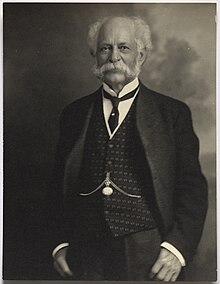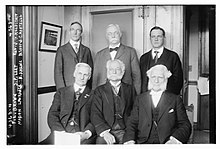Henry John Heinz (October 11, 1844[citation needed] – May 14, 1919) was an American entrepreneur who co-founded the H. J. Heinz Company of Pittsburgh, Pennsylvania.
Henry J. Heinz | |
|---|---|
 Heinz c. 1914 | |
| Born | Henry John Heinz October 11, 1844 Birmingham, Pennsylvania, U.S. |
| Died | May 14, 1919 (aged 74) Pittsburgh, Pennsylvania, U.S. |
| Resting place | Homewood Cemetery |
| Occupation | Business magnate |
| Known for | The creator of tomato ketchup |
| Title | Founder of H. J. Heinz Company |
| Spouse |
Sarah Sloan Young Heinz
(m. 1869; died 1894) |
| Children | 5 |
| Relatives |
|
| Signature | |
 | |

He was involved in the passage of the 1906 Pure Food and Drug Act. Many of his descendants are known for philanthropy and involvement in politics and public affairs. His fortune became the basis for the Heinz Foundations.
Early life
editHenry John Heinz was born in Birmingham, Pennsylvania to John Henry Heinz (1811–1891) and Anna Margaretha Schmidt (1822–1899). John Henry was born Johann Heinrich Heinz to parents Johann Georg and Charlotte Louisa (née Trump) Heinz in Kallstadt of the Palatinate, which at that time was part of the Kingdom of Bavaria. In 1840, John Henry emigrated to Birmingham, where he got a job making bricks and then met and married Anna in 1843, who herself had recently emigrated from Kruspis (today a part of Haunetal), Hesse-Kassel.[1][2] Then when Henry was five years old, his parents moved to Sharpsburg where Henry’s father went into the brick making business for himself. Anna Schmidt was the daughter of a farmer and church administrator, Johann Adam Schmidt, and his wife Dorothea (Thiel) Schmidt.[a] Anna came from Hesse-Kassel, which was a Reformed Protestant (Calvinist) territory, so she was raised in the Calvinist Christian faith.[4] Anna's husband, John Heinz, was a Lutheran, and they raised and confirmed their son to that faith.[1][2][5]
H. J. Heinz Company
editHenry John Heinz began packing foodstuffs on a small scale at Sharpsburg, Pennsylvania, in 1869. There, he founded Heinz Noble & Company with a friend, L. Clarence Noble, and started marketing bottled horseradish, soon followed by sauerkraut, vinegar, and pickles. The company became bankrupt in 1875. The following year, Heinz founded another company, F & J Heinz, with his brother John Heinz and a cousin, Frederick Heinz.[6]
The company continued to grow and, in 1888, Heinz bought out his other two partners and reorganized it as the H. J. Heinz Company, the name carried to the present day. The company's slogan, "57 varieties," was introduced by Heinz in 1896; by then, the company was selling more than 60 different products.[7] Heinz said he chose "5" because it was his lucky number; the number "7" was his wife's lucky number.[8]
The H. J. Heinz Company was incorporated in 1905 with Heinz serving as its first president, retaining that position for the rest of his life.[6] At the time of Heinz's death in Pittsburgh at the age of 74, the H. J. Heinz Company had more than 20 food processing plants and owned seed farms and container factories.[citation needed]
Later life
editHeinz led a successful lobbying effort in favor of the Pure Food and Drug Act in 1906.[9] During World War I, he worked with the Food Administration.[10] He was a director in many financial institutions, and was chairman of a committee to devise ways of protecting Pittsburgh from floods.[10]
Marriage and family
editHeinz married Sarah Sloan Young on September 3, 1869.[1] She was of Scots-Irish ancestry and had grown up in the Presbyterian Church. They had five children:[11]
- Irene Edwilda Heinz-Given (1871–1956)[12]
- Clarence Henry Heinz (1873–1920)[2]
- Howard Covode Heinz (1877–1941)
- Robert Eugene Heinz (1882–1882, lived about 1 month)[2]
- Clifford Sloan Heinz (1883–1935)
They were raised as Presbyterians.
Religious faith
editLater in life Heinz worshipped as a member of Methodist and Presbyterian churches, and worked closely with Baptists as well.[1]
When Heinz visited England, his "tourist stops" included the graves of religious leaders John Bunyan, Isaac Watts, and John Wesley. He visited a chapel that Wesley founded, later writing that "I felt I was upon holy ground."[13] At the beginning of his will Heinz wrote: "I desire to set forth, at the very beginning of this Will, as the most important item in it, a confession of my faith in Jesus Christ as my Savior."[14]
Death and legacy
editHeinz died at his home on May 14, 1919, after contracting pneumonia. His funeral was at East Liberty Presbyterian Church. He was buried at Homewood Cemetery in Pittsburgh, in the Heinz Family Mausoleum.[1][2][15]
A bronze statue of Heinz by Emil Fuchs was dedicated on October 11, 1924, at the Heinz Company building in Pittsburgh.[16]
Heinz is the grandfather of H. J. Heinz II (1908–1987) the great-grandfather of U.S. Senator H. John Heinz III (1938–1991) of Pennsylvania (who was later buried in the same family mausoleum), and great-great grandfather of Henry John Heinz IV, André Thierstein Heinz and Christopher Drake Heinz.[17]
Through his paternal grandmother, Charlotte Louisa Trump, he was a second cousin of Friedrich Trump, second cousin (once removed) of real estate magnate Fred Trump, and second cousin (twice removed) of 45th President of the United States, Donald Trump.[18]
Notes
edit- ^ At least one biographer has erroneously written that Anna's father was a pastor, based on a mistranslation of the German word "Kirchenältester" which appears before Anna's father's name in Anna's baptism record. "Kirchenältester" does not mean "pastor," but rather refers to a lay church administrator who is elected by the parish elders to safeguard the affairs of the church.[3]
References
edit- ^ a b c d e Skrabec, Quentin R. (2009). H.J. Heinz: A Biography. McFarland & Company. pp. 27, 28, 83. ISBN 978-0-7864-4178-5.
- ^ a b c d e McCafferty, E. D. (1923). Henry J. Heinz: a biography. p. 20.
- ^ Grimm, Wilhelm & Jacob (1854). Kirchenältester. Retrieved March 23, 2021.
- ^ Pettegree, Andrew (2000). The Reformation World. Routledge. pp. 399–400. ISBN 9780415163576.
- ^ Dietrich II, William S. (Summer 2008). "H.J. Heinz: Relish success". Pittsburgh Quarterly. Archived from the original on April 2, 2015. Retrieved March 25, 2015.
- ^ a b "H.j. Heinz Company | Encyclopedia.com". www.encyclopedia.com. Retrieved April 10, 2021.
- ^ "Trivia". Heinz. Archived from the original on March 24, 2018. Retrieved March 5, 2015.
- ^ Rawsthorn, Alice (April 12, 2009). "An Icon, Despite Itself". The New York Times. Retrieved June 9, 2009.
- ^ "Heinz Ketchup: A flavorful message in a glass bottle". The State Museum of Pennsylvania. June 30, 2015. Retrieved April 21, 2022.
- ^ a b Reynolds, Francis J., ed. (1921). . Collier's New Encyclopedia. New York: P. F. Collier & Son Company.
- ^ "Henry J. Heinz". Notable Names Database. Soylent Communications. Retrieved January 27, 2013.
- ^ "The Irene Heinz Given and John LaPorte Given Research Professorship of Ophthalmology".
- ^ Alberts, Robert C. (1973). The Good Provider: H. J. Heinz and his 57 Varieties. Houghton Mifflin. p. 76. ISBN 978-0-213-16481-2.
- ^ Lee, Richard (2011). In God We Still Trust: A 365-Day Devotional. Thomas Nelson Inc. p. 100. ISBN 978-1-4041-8965-2.
- ^ Robinson Library[usurped]
- ^ "Henry J. Heinz Memorial, (sculpture)". Art Inventory Archive. Retrieved October 11, 2014.
- ^ "Family tree of Henry John Heinz". Geneanet. Retrieved August 25, 2023.
- ^ "Family tree of Donald John Trump". Geneanet. Retrieved August 25, 2023.
Further reading
edit- "Henry Heinz and Brand Creation in the Late Nineteenth Century: Making Markets for Processed Food" by Nancy Koehn. The Business History Review, Vol. 73 (Autumn, 1999), pp. 349–393. JSTOR 3116181, reprinted in Koehn, Nancy F. Koehn, Brand New : How Entrepreneurs Earned Consumers' Trust from Wedgwood to Dell (2001) pp 43–90.
External links
editQuotations related to Henry J. Heinz at Wikiquote